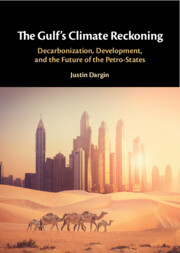Refine search
Actions for selected content:
117 results
8 - Weaning a House and the World from Fossil Fuels
- from Part I - Eight Articles from the Bulletin of the Atomic Scientists
-
- Book:
- Climate Change Science
- Published online:
- 13 November 2025
- Print publication:
- 20 November 2025, pp 43-52
-
- Chapter
- Export citation
7 - From Crude to Clean: The Renewable Energy Surge
- from Part II - Reinventing the Petro-State: The Gulf’s Race against the Climate Clock
-
- Book:
- The Gulf's Climate Reckoning
- Published online:
- 13 October 2025
- Print publication:
- 30 October 2025, pp 180-210
-
- Chapter
- Export citation
Introduction - Climate Crossroads – Gulf Decarbonization and the Legacy of Oil
-
- Book:
- The Gulf's Climate Reckoning
- Published online:
- 13 October 2025
- Print publication:
- 30 October 2025, pp 1-12
-
- Chapter
- Export citation
Enablers of net-zero transition: A holistic model of energy policy, innovation and infrastructure
-
- Journal:
- Cambridge Prisms: Energy Transitions / Volume 1 / 2025
- Published online by Cambridge University Press:
- 27 October 2025, e8
-
- Article
-
- You have access
- Open access
- HTML
- Export citation
1 - Introduction
-
- Book:
- Governing Energy Transitions
- Published online:
- 26 September 2025
- Print publication:
- 16 October 2025, pp 1-23
-
- Chapter
-
- You have access
- Open access
- HTML
- Export citation

The Gulf's Climate Reckoning
- Decarbonization, Development, and the Future of the Petro-States
-
- Published online:
- 13 October 2025
- Print publication:
- 30 October 2025
7 - Renewable Energy and Energy Efficiency in Circular Economy Liveable Cities
-
-
- Book:
- The Circular Economy and Liveable Cities
- Published online:
- 05 September 2025
- Print publication:
- 04 September 2025, pp 101-111
-
- Chapter
- Export citation
5 - Nobody Is Spared
-
- Book:
- From Crisis to Action
- Published online:
- 15 August 2025
- Print publication:
- 04 September 2025, pp 93-110
-
- Chapter
-
- You have access
- Open access
- HTML
- Export citation
15 - How Do Science and Technology Impact International Development, and How Might They Lead to a More Sustainable Global Community?
-
- Book:
- Understanding Technology and Society
- Published online:
- 30 September 2025
- Print publication:
- 10 July 2025, pp 174-190
-
- Chapter
- Export citation
Introduction
-
- Book:
- Decarbonising Electricity
- Published online:
- 20 June 2025
- Print publication:
- 03 July 2025, pp 1-18
-
- Chapter
- Export citation
1 - The Promise of Renewable Energy
-
- Book:
- Decarbonising Electricity
- Published online:
- 20 June 2025
- Print publication:
- 03 July 2025, pp 19-52
-
- Chapter
- Export citation
The Norwegian Transparency Act, Renewable Energy and Extractive Industries: Towards a Just Transition for the Indigenous Sámi People
-
- Journal:
- Business and Human Rights Journal / Volume 10 / Issue 1 / February 2025
- Published online by Cambridge University Press:
- 09 May 2025, pp. 267-273
-
- Article
-
- You have access
- Open access
- HTML
- Export citation
Modelling outlet power loss in Archimedes screw generators
-
- Journal:
- Flow: Applications of Fluid Mechanics / Volume 4 / 2024
- Published online by Cambridge University Press:
- 28 March 2025, E32
-
- Article
-
- You have access
- Open access
- HTML
- Export citation
China's Continuing Green Shift in the Electric Power Sector: Evidence from 2016 data
-
- Journal:
- Asia-Pacific Journal / Volume 15 / Issue 10 / May 2017
- Published online by Cambridge University Press:
- 14 March 2025, e4
-
- Article
-
- You have access
- Open access
- Export citation
China's renewable energy revolution: what is driving it?
-
- Journal:
- Asia-Pacific Journal / Volume 12 / Issue 44 / November 2014
- Published online by Cambridge University Press:
- 14 March 2025, e3
-
- Article
-
- You have access
- Open access
- Export citation
A Positive Legacy? UN Peace Operations and Renewable Energy
-
- Journal:
- Ethics & International Affairs / Volume 38 / Issue 4 / Winter 2024
- Published online by Cambridge University Press:
- 04 March 2025, pp. 444-463
-
- Article
-
- You have access
- Open access
- HTML
- Export citation
1 - Carbon Neutrality in the GCC
- from Part I - Introduction
-
-
- Book:
- Carbon Neutrality in the Gulf
- Published online:
- 02 January 2025
- Print publication:
- 16 January 2025, pp 3-8
-
- Chapter
- Export citation
14 - Outlook of Net Zero GCC States
- from Part VI - Conclusion
-
-
- Book:
- Carbon Neutrality in the Gulf
- Published online:
- 02 January 2025
- Print publication:
- 16 January 2025, pp 309-314
-
- Chapter
- Export citation
Legal Imperatives for the Implementation of Energy Auctions in Nigeria
-
- Journal:
- Journal of African Law / Volume 69 / Issue 1 / February 2025
- Published online by Cambridge University Press:
- 18 December 2024, pp. 129-145
- Print publication:
- February 2025
-
- Article
-
- You have access
- Open access
- HTML
- Export citation
7 - Hydrogen Regulation in Southeast Asia
- from Part I - Current Hydrogen Regulation on the Continents
-
-
- Book:
- The Cambridge Handbook of Hydrogen and the Law
- Published online:
- 28 November 2024
- Print publication:
- 28 November 2024, pp 98-112
-
- Chapter
-
- You have access
- Open access
- HTML
- Export citation
